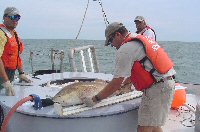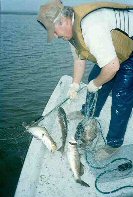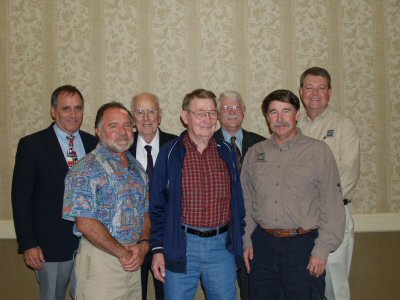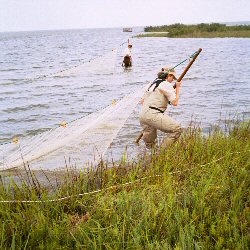Coastal Fisheries Management--30 Years Plus and Counting
By Paul Hammerschmidt, Coastal Fisheries, Austin HQ
What do 40,000 bag seines, 60,000 trawls, 40,000 oyster dredge samples, 20,000 gill net sets and 250,000 angler interviews have to do with a celebration? They represent millions of data points generated by the Texas Parks and Wildlife Department's Coastal Fisheries Division over the last three decades of continuous resource monitoring.

This TPWD database one of the largest, and possibly THE longest continuous, marine resources dataset in the world. Further, information gained from the database has been the basis for resource management decisions and regulations that have helped create an economic impact of almost $2 billion annually in Texas, improved the quality of fishing, and laid the foundations for sustaining our fish and shellfish populations. It has also been utilized in successful efforts to secure freshwater inflows, and to protect the water quality of Texas' estuaries, which are critical habitats for fisheries. So there was a celebration and information exchange in November, 2005.

Coastal Fisheries sponsored a symposium to mark the occasion entitled "30 Years of Continuous Resource Monitoring and 30 Years of Management Success". The highlight of the symposium was the panel of former Coastal Fisheries Directors -- the contributions and experiences of which span almost 60 years of fisheries management. The participants were Tom Moore, Ernest Simmons, Dr. Gary Matlock, Ralph Rayburn, Gene McCarty and Hal Osburn.

The concept of a good science-based continuous monitoring program was not new in the 1970's. But, under the vision of Bob Kemp and with the guidance of Dr. Gary Matlock it gathered momentum and began to gel into a working system that incorporated a holistic view of fisheries management. Gary and many staff designed and implemented a scientifically sound monitoring program that eventually would encompass every bay system on the Texas coast. The data would be collected the same way from Brownsville to Port Arthur, and the marching orders were "If you catch it, you count it and you measure it." Most importantly, the data sets generated in this manner allowed biologists and managers a view of the trends in fish populations that was scientifically sound.
In those early days, the trends that caught a lot of attention were serious declines in two of the most popular fish species in Texas, red drum and spotted seatrout. This information caused TPWD to begin implementing strict management measures in an attempt to stop and reverse what they were observing. As one might expect, not everyone agreed that there was a problem, nor did they believe the dataset or what it was showing. Because this was the first time such data had been used to regulate a popular fish species, a long and sometimes painful, test of the program and its methodologies ensued. Fortunately, the science behind the new procedures prevailed both in the State courts and in the court of public opinion. Coastal Fisheries program credibility was validated.

The Coastal Fisheries data have also supported significant fishery management decisions during the 1980's, 1990's and into 2000. Under the leadership of former directors like Gary Matlock, Ralph Rayburn, Gene McCarty and Hal Osburn, several management successes were realized. Nets were banned from all Texas bays; red drum and spotted seatrout were designated game fish. The TPW Commission adopted management plans for the shrimp, oyster and crab fisheries. The Legislature then gave the agency authority to manage shrimp and oysters. Limited entry into the commercial bay and bait shrimp, blue crab and finfish fisheries was implemented, along with license commercial buyback programs; a first for any state in the Gulf of Mexico. None of these management decisions came easily, but again, the strength of the data and the science behind it was substantial.

Finally, the contributions of two of the most venerable former directors of Coastal Fisheries cannot be forgotten. Tom Moore began work with TPWD (then the Texas Game and Fish Commission) in 1947. As regional director for the West Texas region, he was responsible for terrestrial, freshwater and saltwater resource management. Ernest Simmons began working with the agency in 1948 and spearheaded uniform sampling. Although the methodologies of resource management have changed, these gentlemen biologists paved the way to the development of the programs in use today.
Now, midway through the first decade of the new century the Coastal Fisheries and Resource Protection Divisions have united into a single Division. That merger catalyzed everyone's resolve to learn from the last 30 years of coastal resource management successes, and begin charting the course of new and stronger ecosystem management into the next 30 years. The broad milestones have been set by the goals and objectives of the agency�s "Land and Water Resources Conservation a nd Recreation Plan". Coastal Fisheries' vision will be framed by the strategy of an ecosystem-based approach to resource management. Another article, will detail this ecosystem-based marine resource management plan.
The upshot of all this is that a new Coastal Fisheries Division Operating Plan will make sure the actions recommended are dynamic and capable of making rapid changes. Such elastic plans are necessary if we are to assure that Texas� bays and estuaries are conserved for the moving target we call our future.
© Copyright Texas Parks and Wildlife Department. No part of this work may be copied, reproduced, or translated in any form or medium without the prior written consent of Texas Parks Wildlife Department except where specifically noted. If you want to use these articles, see Site Policies